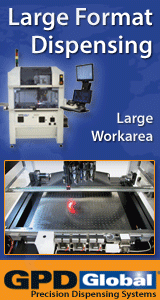Printed Circuit Board Assembly & PCB Design Forum
SMT electronics assembly manufacturing forum.
- SMTnet
- »
- Electronics Forum
- »
- Selective Soldering Equipment
Selective Soldering Equipment
Views: 5985
![]() A recent thread regarding the ACE KISS equipment has me wond...
- Nov 26, 2007
by
hoss67
A recent thread regarding the ACE KISS equipment has me wond...
- Nov 26, 2007
by
hoss67
![]()
![]()
![]() Good luck. Being most machines use the edge of the board to...
- Nov 26, 2007
by
Real Chunks
Good luck. Being most machines use the edge of the board to...
- Nov 26, 2007
by
Real Chunks
![]()
![]()
![]() Alot of that depends on your designs as well. Poor designs ...
- Nov 27, 2007
by
Dirk Nuendyke
Alot of that depends on your designs as well. Poor designs ...
- Nov 27, 2007
by
Dirk Nuendyke
![]()
![]()
![]() To be successful, and to yield quality products off any sele...
- Dec 05, 2007
by
MFGuy
To be successful, and to yield quality products off any sele...
- Dec 05, 2007
by
MFGuy
![]()
![]()
![]() If you are looking for fiducial recognition the RPS automati...
- Dec 06, 2007
by
Tech
If you are looking for fiducial recognition the RPS automati...
- Dec 06, 2007
by
Tech
![]()
![]()
![]() We use a dual pot ERSA system. It is outstanding. Saved abou...
- Dec 06, 2007
by
Lysik
We use a dual pot ERSA system. It is outstanding. Saved abou...
- Dec 06, 2007
by
Lysik
![]()
![]()
![]() You say designing for the processes is good.
...
- Dec 06, 2007
by
Real Chunks
You say designing for the processes is good.
...
- Dec 06, 2007
by
Real Chunks
![]()
![]()
![]() Not only is "designing for the processes is good", it should...
- Dec 06, 2007
by
MFGuy
Not only is "designing for the processes is good", it should...
- Dec 06, 2007
by
MFGuy
![]()
![]()
![]() What kind of engineers? Some engineers are so clueless they...
- Dec 07, 2007
by
Real Chunks
What kind of engineers? Some engineers are so clueless they...
- Dec 07, 2007
by
Real Chunks
![]()
![]()
![]() 3000???? You sure you didn't put a digit too much there?
...
- Dec 07, 2007
by
Loco
3000???? You sure you didn't put a digit too much there?
...
- Dec 07, 2007
by
Loco
![]()
![]()
![]() Well first of all, you can�t even go NEAR the machine unless...
- Dec 07, 2007
by
Dirk Nuendyke
Well first of all, you can�t even go NEAR the machine unless...
- Dec 07, 2007
by
Dirk Nuendyke
![]()
![]()
![]() Even if it is 300 hours, using a conservative estimate of th...
- Dec 07, 2007
by
dyoungquist
Even if it is 300 hours, using a conservative estimate of th...
- Dec 07, 2007
by
dyoungquist
![]()
![]()
![]() The 3000 hours is correct. It was a VERY fast ROI!
Back ...
- Dec 07, 2007
by
gmoney
The 3000 hours is correct. It was a VERY fast ROI!
Back ...
- Dec 07, 2007
by
gmoney
![]()
- SMTnet
- »
- Electronics Forum
- »
- Selective Soldering Equipment






